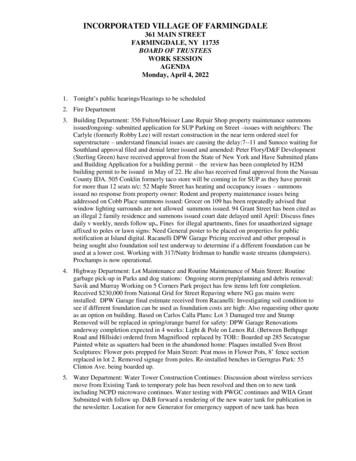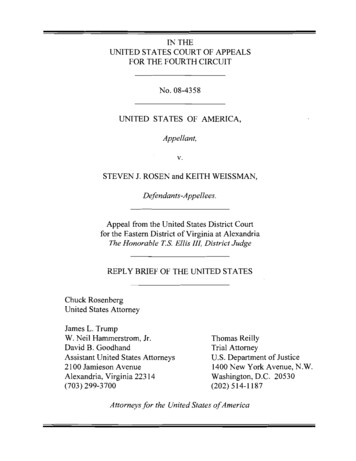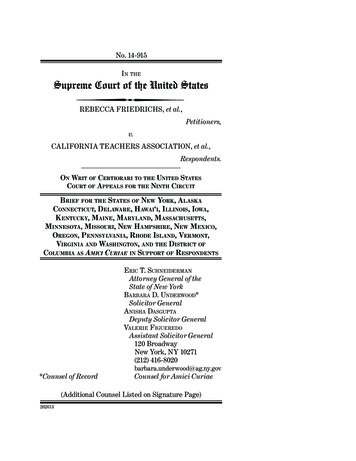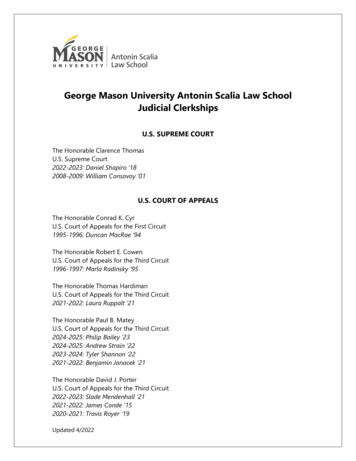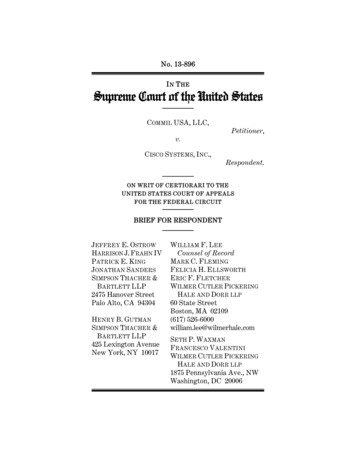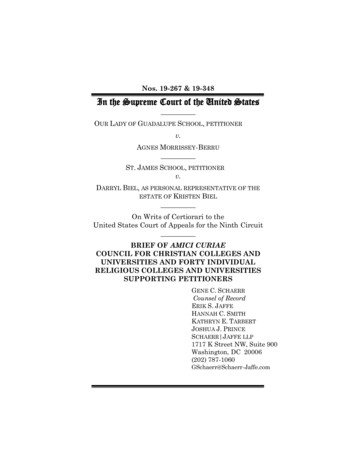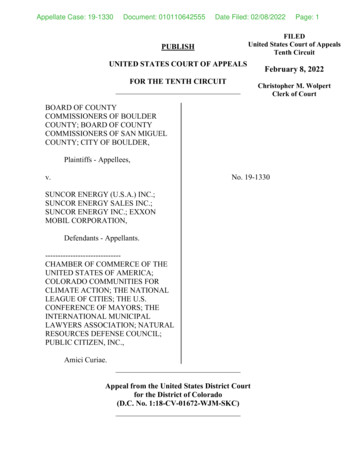
Transcription
Appellate Case: 19-1330Document: 010110642555Date Filed: 02/08/2022FILEDUnited States Court of AppealsTenth CircuitPUBLISHUNITED STATES COURT OF APPEALSFOR THE TENTH CIRCUITFebruary 8, 2022Christopher M. WolpertClerk of CourtBOARD OF COUNTYCOMMISSIONERS OF BOULDERCOUNTY; BOARD OF COUNTYCOMMISSIONERS OF SAN MIGUELCOUNTY; CITY OF BOULDER,Plaintiffs - Appellees,v.Page: 1No. 19-1330SUNCOR ENERGY (U.S.A.) INC.;SUNCOR ENERGY SALES INC.;SUNCOR ENERGY INC.; EXXONMOBIL CORPORATION,Defendants - Appellants.-----------------------------CHAMBER OF COMMERCE OF THEUNITED STATES OF AMERICA;COLORADO COMMUNITIES FORCLIMATE ACTION; THE NATIONALLEAGUE OF CITIES; THE U.S.CONFERENCE OF MAYORS; THEINTERNATIONAL MUNICIPALLAWYERS ASSOCIATION; NATURALRESOURCES DEFENSE COUNCIL;PUBLIC CITIZEN, INC.,Amici Curiae.Appeal from the United States District Courtfor the District of Colorado(D.C. No. 1:18-CV-01672-WJM-SKC)
Appellate Case: 19-1330Document: 010110642555Date Filed: 02/08/2022Page: 2Kannon K. Shanmugam, Paul, Weiss, Rifkind, Wharton & Garrison LLP, Washington,D.C. (William T. Marks, Paul, Weiss, Rifkind, Wharton & Garrison LLP, Washington,D.C.; Theodore V. Wells, Jr., Daniel J. Toal, Jaren Janghorbani, Paul, Weiss, Rifkind,Wharton & Garrison LLP, New York, New York; Colin G. Harris, Faegre Baker DanielsLLP, Boulder, Colorado; and Hugh Quan Gottschalk, Evan B. Stephenson, WheelerTrigg O’Donnell LLP, Denver, Colorado, with him on the briefs), for Defendants –Appellants.Richard Herz, EarthRights International, Washington, D.C. (Marco Simons, SeanPowers, Michelle Harrison, EarthRights International, Washington, D.C.; David G.Bookbinder, Niskanen Center, Washington, D.C.; and Kevin S. Hannon, The HannonLaw Firm, Denver, Colorado, with him on the brief), for Plaintiff – Appellee.Peter D. Keisler, C. Frederick Beckner III, and Ryan C. Morris, Sidley Austin LLP,Washington, D.C., filed an amicus brief on behalf of Chamber of Commerce of theUnited States of America.W. Eric Pilsk, Sarah M. Keane, Sara V. Mogharabi, and Samantha R. Caravello, KaplanKirsch & Rockwell LLP, Denver, Colorado, filed an amicus brief on behalf of ColoradoCommunities for Climate Action.Robert S. Peck, Center for Constitutional Litigation, P.C., Washington, D.C., filed anamicus brief on behalf of the National League of Cities, the United States Conference ofMayors, and the International Municipal Lawyers Association.Peter Huffman, Natural Resources Defense Council, Washington, D.C., filed an amicusbrief on behalf of the Natural Resources Defense Council.Scott L. Nelson and Allison M. Zieve, Public Citizen Litigation Group, Washington,D.C., filed an amicus brief on behalf of Public Citizen.Before HOLMES, LUCERO, and McHUGH, Circuit Judges.McHUGH, Circuit Judge.This matter is before us on remand from the United States Supreme Court. SuncorEnergy (U.S.A.) Inc. v. Bd. of Cnty. Comm’rs of Boulder Cnty., 141 S. Ct. 2667 (2021)2
Appellate Case: 19-1330Document: 010110642555Date Filed: 02/08/2022Page: 3(Mem.). The case originally came to us as an appeal of the district court’s orderremanding the action to state court. Pursuant to 28 U.S.C. § 1447(d), orders remandingremoved cases to state court are not appealable “except that an order remanding a case tothe State court from which it was removed pursuant to section 1442 [federal officerremoval] or 1443 [civil rights cases] of this title shall be reviewable by appeal orotherwise.” In our prior decision, we held § 1447(d) limited our appellate jurisdiction toreview of only the federal officer basis for removal, which was one of six grounds offederal subject-matter jurisdiction advanced in support of removal on appeal. Bd. of Cnty.Comm’rs of Boulder Cnty. v. Suncor Energy (U.S.A.) Inc., 965 F.3d 792, 819 (10th Cir.2020), vacated and remanded by 141 S. Ct. 2667 (2021) (Mem.).In BP P.L.C. v. Mayor & City Council of Baltimore, the Supreme Court rejectedthat position, holding that when a removal action is appealed under the limited groundslisted in 28 U.S.C. § 1447(d), the appellate court has subject-matter jurisdiction over allgrounds for removal addressed in the district court’s order. 141 S. Ct. 1532, 1543 (2021).The Court then granted certiorari in this case, vacated our prior decision, and remandedfor further consideration in light of its decision in BP v. Mayor & City Council ofBaltimore. Suncor Energy (U.S.A.) Inc. v. Bd. of Cnty. Comm’rs of Boulder Cnty., 141 S.Ct. 2667 (2021) (Mem.).We undertake that further consideration now. For the following reasons, we holdthat none of the six grounds asserted support federal removal jurisdiction. Accordingly,we affirm the district court’s order remanding the action to state court.3
Appellate Case: 19-1330Document: 010110642555Date Filed: 02/08/2022Page: 4BACKGROUNDFactual HistoryThe Energy Companies and Climate Change1Stated broadly, this is a lawsuit about damages related to climate change. TheBoard of County Commissioners of Boulder County, the Board of CountyCommissioners of San Miguel County, and the City of Boulder (collectively, the“Municipalities”) say they have experienced and will continue to experience harmbecause of climate change caused by fossil-fuel consumption and rising levels of carbondioxide in the atmosphere. They also allege they have spent and will continue spendingmillions of dollars to mitigate this harm.The Municipalities contend that Suncor Energy (U.S.A.) Inc., Suncor EnergySales, Inc., Suncor Energy, Inc., and ExxonMobil Corporation (“Exxon”) (collectively,the “Energy Companies”) have contributed significantly to the changing climate inColorado by producing, marketing, and selling fossil fuels. And the Municipalities allegethe Energy Companies have continued their fossil-fuel activities even though they knewthese activities would change the climate dramatically. The Municipalities further allegethe Energy Companies concealed and/or misrepresented the dangers associated with theburning of fossil fuels despite having been aware of those dangers for decades.1When courts review a notice of removal for jurisdiction, they may consider thecomplaint as well as documents attached to the notice of removal. See McPhail v. Deere& Co., 529 F.3d 947, 955–56 (10th Cir. 2008). Thus, we take these facts from theAmended Complaint and the other documents attached to the Notice of Appeal.4
Appellate Case: 19-1330Document: 010110642555Date Filed: 02/08/2022Page: 5Exxon’s Outer Continental Shelf LeasesOn appeal, the Energy Companies contend there is federal jurisdiction over theMunicipalities’ claims, in part, because Exxon and/or its affiliated companies have leasedand continue to lease portions of the outer continental shelf of the United States (“OCS”)pursuant to the Outer Continental Shelf Lands Act (“OCSLA”) to extract fossil fuels.Accordingly, we include relevant background information about the OCS leases.The OCS “is a vast underwater expanse” that begins several miles off the coastlineand extends seaward for roughly two hundred miles. Ctr. for Sustainable Econ. v. Jewell,779 F.3d 588, 592 (D.C. Cir. 2015). The “subsoil and seabed” of the OCS “appertain tothe United States and are subject to its jurisdiction and control.” 43 U.S.C. § 1331(a).“Billions of barrels of oil and trillions of cubic feet of natural gas lie beneath the OCS.”Jewell, 779 F.3d at 592.Pursuant to the OCSLA, the Department of Interior (“DOI”) administers a federalleasing program to develop and make use of the OCS’s oil and gas resources. See 43U.S.C. §§ 1334–1356b. The Interior Secretary “is authorized to grant to the highestresponsible qualified bidder or bidders by competitive bidding . . . any oil and gas lease”on these submerged lands. 43 U.S.C. § 1337(a)(1). For decades, Exxon has participatedin this competitive leasing program, and it continues to conduct operations under OCSleases.By the terms of its OCS leases, Exxon is required to conduct drilling “inaccordance with” federally approved exploration, development, and production plans andconditions. App. at 64 § 9. These plans must “conform to sound conservation practices to5
Appellate Case: 19-1330Document: 010110642555Date Filed: 02/08/2022Page: 6preserve, protect, and develop minerals resources and maximize the ultimate recovery ofhydrocarbons from the leased area.” Id. § 10. Exxon is obligated to “exercise diligence inthe development of the leased area and in the production of wells located thereon;”“prevent unnecessary damage to, loss of, or waste of leased resources;” and “comply withall applicable laws, regulations and orders related to diligence, sound conservationpractices and prevention of waste.” Id. Earlier OCS leases further provided, “[a]fter duenotice in writing, the Lessee shall drill such wells and produce at such rates as the Lessormay require in order that the leased area or any part thereof may be properly and timelydeveloped and produced in accordance with sound operating principles.” Id. at 50 § 10.That provision is not included in the current leases.The leases provide DOI officials reserve the right to obtain “prompt access” tofacilities and records of private OCS lessees for the purpose of federal safety, health, orenvironmental inspections. Id. at 64 § 12. The government reserves a right of first refusalto purchase all materials “[i]n time of war or when the President of the United States shallso prescribe.” Id. at 68 § 15(d). The government also requires that 20% of all crude ornatural gas produced pursuant to drilling leases be offered “to small or independentrefiners.” Id. § 15(c).Procedural HistoryThe ClaimsIn this action, the Municipalities sue for damages allegedly caused by climatechange. They assert a variety of claims under Colorado law, both common law andstatutory, against the Energy Companies. Specifically, the Municipalities allege claims of6
Appellate Case: 19-1330Document: 010110642555Date Filed: 02/08/2022Page: 7public nuisance; private nuisance; trespass; unjust enrichment; violation of the ColoradoConsumer Protection Act, Colo. Rev. Stat. § 6-1-105(1), et seq.; and civil conspiracy.They do not allege any federal claims.The Municipalities seek compensatory damages, remediation and/or abatement,treble damages, and costs and attorney fees. The Municipalities also ask that the EnergyCompanies be held jointly liable under Colorado Revised Statutes § 13-21-111.5(4) for“consciously conspir[ing] and deliberately pursu[ing] a common plan to commit tortiousacts.” Id. at 194–95 The Municipalities expressly do not seek to interfere with or imposeliability based on the Energy Companies’ speech; to “enjoin any oil and gas operations orsales in the State of Colorado, or elsewhere, or to enforce emissions controls of anykind;” to recover “damages or abatement relief for injuries to or occurring on federallands;” or to impose liability based on any act potentially deemed lobbying or petitioning.Id. at 193. That is, the Municipalities do not ask the court “to stop or regulate” fossil-fuelproduction or emissions “in Colorado or elsewhere.” Id. at 74. They instead request thatthe Energy Companies “help remediate the harm caused by their intentional, reckless andnegligent conduct, specifically by paying their share of the costs [the Municipalities]have incurred and will incur because of [the Energy Companies’] contribution toalteration of the climate.” Id.The Notice of Removal and the District Court’s Remand OrderAfter the Municipalities filed their Amended Complaint in Colorado state court,the Energy Companies filed a Notice of Removal in the United States District Court forthe District of Colorado. In that Notice, they asserted seven grounds for removal. Five of7
Appellate Case: 19-1330Document: 010110642555Date Filed: 02/08/2022Page: 8those grounds were under the general removal statute, 28 U.S.C. § 1441(a), allowing forremoval of “any civil action brought in a State court of which the district courts of theUnited States have original jurisdiction.” Specifically, the Energy Companies contendedthat 28 U.S.C. § 1331 conferred original jurisdiction over the claims because (1) theMunicipalities’ claims arose only under federal common law; (2) the Clean Air Act(“CAA”) completely preempted the state-law claims; (3) the claims implicated disputedand substantial “federal issues” under Grable & Sons Metal Products, Inc. v. DarueEngineering & Manufacturing, 545 U.S. 308 (2005); (4) the claims arose from incidentsthat occurred in federal enclaves within the Municipalities’ borders; and (5) originalfederal jurisdiction exists under the OCSLA. In addition, the Energy Companies assertedoriginal federal jurisdiction was available under (6) the federal officer removal statute, 28U.S.C. § 1442(a), and (7) the bankruptcy removal statute, 28 U.S.C. § 1452(a).The Municipalities timely filed a Motion to Remand pursuant to 28 U.S.C.§ 1447(c). In a detailed opinion, the district court rejected all asserted grounds forremoval and remanded the action to state court.The AppealThe Energy Companies appealed the district court’s remand order on six grounds,including the federal officer removal statute, 28 U.S.C. § 1442, pursuant to 28 U.S.C.§ 1447(d). They argued that appealing the remand order under the federal officer removalstatute gave this court jurisdiction to consider all the grounds for removal asserted, notjust federal officer removal. On plenary review, we disagreed and held that ourjurisdiction was limited to the federal officer removal question. Suncor Energy, 965 F.3d8
Appellate Case: 19-1330Document: 010110642555Date Filed: 02/08/2022Page: 9at 819. Concluding that the requirements for federal officer removal had not beensatisfied, we affirmed the district court’s remand order without considering the othergrounds for removal. Id. at 827.The Supreme Court has now clarified that in circumstances such as the present,where federal officer removal is one of multiple grounds for removal, the entire order ofremand is reviewable on appeal. BP v. Mayor & City Council of Balt., 141 S. Ct. at 1543.Thus, our jurisdiction extends beyond the federal officer removal statute to all groundsadvanced for federal jurisdiction over the action. The Court vacated our opinion andremanded to us for reconsideration. See Suncor Energy, 141 S. Ct. at 2667.On remand from the Supreme Court, we requested supplemental briefing from theparties. The Municipalities seek affirmance of the district court’s decision remanding theaction to Colorado state court, and the Energy Companies again claim removal is proper.DISCUSSIONOn appeal, the Energy Companies challenge the district court’s remand order,relying on six grounds for federal jurisdiction under § 1442, the federal officer removalstatute, and § 1441, the general removal statute. Under § 1442, the Energy Companiescontend Exxon acted under a federal officer, which establishes (1) federal officerremoval. And under § 1441, they contend there is original federal jurisdiction over theMunicipalities’ claims because (2) the claims arise under federal common law; (3) theCAA completely preempts the Municipalities’ state-law claims; (4) the claims necessarilyraise substantial federal issues; (5) there is federal enclave jurisdiction; and (6) theOCSLA establishes original federal jurisdiction over these claims.9
Appellate Case: 19-1330Document: 010110642555Date Filed: 02/08/2022Page: 10We begin our analysis with a discussion of the relevant standard of review. Then,we discuss the merits of each proposed basis of federal subject-matter jurisdiction.Ultimately, we conclude the district court correctly rejected each ground, and we affirmthe district court’s remand order.Standard of Review“Only state-court actions that originally could have been filed in federal court maybe removed to federal court by the defendant.” Caterpillar Inc. v. Williams, 482 U.S. 386,392 (1987). “‘Federal courts are courts of limited jurisdiction.’” Gunn v. Minton, 568U.S. 251, 256 (2013) (quoting Kokkonen v. Guardian Life Ins. Co. of Am., 511 U.S. 375,377 (1994)). So “there is a presumption against our jurisdiction.” Merida Delgado v.Gonzales, 428 F.3d 916, 919 (10th Cir. 2005) (quotation marks omitted).The presumption against jurisdiction is manifested in “the deeply felt andtraditional reluctance of th[e Supreme] Court to expand the jurisdiction of the federalcourts through a broad reading of jurisdictional statutes.” Romero v. Int’l TerminalOperating Co., 358 U.S. 354, 379 (1959), superseded on other grounds by statute, TheJones Act, 45 U.S.C. § 59, as recognized in Miles v. Apex Marine Corp., 498 U.S. 19(1990). Thus, “statutes conferring jurisdiction on federal courts are to be strictlyconstrued, and doubts resolved against federal jurisdiction.” United States ex rel. King v.Hillcrest Health Ctr., Inc., 264 F.3d 1271, 1280 (10th Cir. 2001) (quotation marksomitted). The Energy Companies, as the parties removing to federal court, bear theburden of establishing jurisdiction by a preponderance of the evidence. Dutcher v.Matheson, 733 F.3d 980, 985 (10th Cir. 2013).10
Appellate Case: 19-1330Document: 010110642555Date Filed: 02/08/2022Page: 11“We review the district court's ruling on the propriety of removal de novo.”Frederick v. Hartford Underwriters Ins. Co., 683 F.3d 1242, 1245 (10th Cir. 2012). Wealso apply de novo review to questions of federal subject-matter jurisdiction. NavajoNation v. Dalley, 896 F.3d 1196, 1203 (10th Cir. 2018).Grounds Asserted for Federal JurisdictionIn our prior decision, we rejected the Energy Companies’ reliance on § 1442, thefederal officer removal statute. Suncor Energy, 965 F.3d at 819–27. Because the SupremeCourt vacated our prior decision, we again consider that issue here. Then, we addresseach of the other grounds advanced for federal subject-matter jurisdiction, including adiscussion of the district court’s ruling on each issue.28 U.S.C. § 1442(a): Federal Officer Removal JurisdictionThe Energy Companies argue there is federal jurisdiction and this action isremovable because Exxon acted under a federal officer pursuant to its OCS leases.2 Thedistrict court held that any control exercised by federal officers over Exxon’s operationsthrough the issuance of government leases to develop fossil fuels on the OCS wasinsufficient to trigger federal jurisdiction under § 1442. We agree.The federal officer removal statute permits removal of a state court civil action“that is against or directed to . . . any officer (or any person acting under that officer) of2Exxon is the only party that allegedly acted under a federal officer. Section 1442,however, allows for independent removal of an entire case by “only one of several nameddefendants.” Akin v. Ashland Chem. Co., 156 F.3d 1030, 1034 (10th Cir. 1998). Thus, ifExxon can show it acted under a federal officer such that this case is removable under§ 1442, the entire case is removable.11
Appellate Case: 19-1330Document: 010110642555Date Filed: 02/08/2022Page: 12the United States or of any agency thereof . . . for or relating to any act under color ofsuch office.” 28 U.S.C. § 1442(a)(1). The statute’s “‘basic purpose’ is to protect againstthe interference with federal operations that would ensue if a state were able to arrestfederal officers and agents acting within the scope of their authority and bring them totrial in a state court for an alleged state-law offense.” Mayor & City Council of Balt. v.BP P.L.C. (Baltimore II), 952 F.3d 452, 461 (4th Cir. 2020) (quoting Watson v. PhillipMorris Cos., Inc., 551 U.S. 142, 150 (2007)), vacated and remanded on other grounds by141 S. Ct. 1532 (2021).3 Unlike other removal statutes, it should “be liberally construedto give full effect to th[at] purpose[].” Colorado v. Symes, 286 U.S. 510, 517 (1932).Section 1442(a)(1) removal can apply to private persons “who lawfully assist”federal officers “in the performance of [their] official dut[ies],” Davis v. South Carolina,107 U.S. 597, 600 (1883), meaning the private person must be “‘authorized to act with orfor [federal officers or agents] in affirmatively executing duties under . . . federal law,’”Watson, 551 U.S. at 151 (alterations in original) (quoting City of Greenwood v. Peacock,384 U.S. 808, 824 (1966)). And § 1442(a)(1) also allows removal by privatecorporations. Isaacson v. Dow Chem. Co., 517 F.3d 129, 135–36 (2d Cir. 2008). In eithercase, private defendants may remove under § 1442(a)(1) if they can show (1) they actedunder the direction of a federal officer, (2) the claim has a connection or association with3This is the appellate court’s decision reviewing Mayor & City Council of Balt. v.BP, P.L.C. (Baltimore I), 388 F. Supp. 3d 538, 565 (D. Md. 2019), aff’d in part by 952F.3d 452 (4th Cir. 2020), which we cite later in this opinion. Because other cases we citealso name BP P.L.C. as a party, we distinguish these two cases by referring to the districtcourt’s opinion as Baltimore I and the appellate court’s opinion as Baltimore II.12
Appellate Case: 19-1330Document: 010110642555Date Filed: 02/08/2022Page: 13government-directed conduct, and (3) they have a colorable federal defense to the claimor claims. 28 U.S.C. § 1442(a)(1); Latiolais v. Huntington Ingalls, Inc., 951 F.3d 286,296 (5th Cir. 2020); Sawyer v. Foster Wheeler LLC, 860 F.3d 249, 254 (4th Cir. 2017);see also Greene v. Citigroup, Inc., No. 99-1030, 2000 WL 647190, at *2 (10th Cir. May19, 2000) (unpublished) (applying a similar three-part test for federal officer removaljurisdiction). Exxon has failed to establish the first element of federal officer removaljurisdiction.“The statutory phrase ‘acting under’ describes ‘the triggering relationship betweena private entity and a federal officer.’” Baltimore II, 952 F.3d at 462 (quoting Watson,551 U.S. at 149). “The words ‘acting under’ are broad,” but “not limitless.” Watson, 551U.S. at 147. In this context, “under” describes a relationship between private entity andfederal superior typically involving “‘subjection, guidance, or control.’” Id. at 151(quoting WEBSTER’S NEW INTERNATIONAL DICTIONARY 2765 (2d ed. 1953)). Thus, a“private person’s ‘acting under’ must involve an effort to assist, or to help carry out, theduties or tasks of the federal superior.” Id. at 152. This “help or assistance necessary tobring a private person within the scope of the statute does not include simply complyingwith the law[] . . . , even if the regulation is highly detailed and even if the private firm’sactivities are highly supervised and monitored.” Id. at 152–53. Rather, “there must exist a‘special relationship’ between” the private firm and the federal superior. Isaacson, 517F.3d at 137 (quoting Watson, 551 U.S. at 157).In Watson, “the Court considered whether the Philip Morris Companies were‘acting under’ a federal officer or agency when they tested and advertised their cigarettes13
Appellate Case: 19-1330Document: 010110642555Date Filed: 02/08/2022Page: 14in compliance with the Federal Trade Commission’s [(“FTC”)] detailed regulations.” Id.at 136. The defendants highlighted various lower court cases holding that governmentcontractors could invoke § 1442 removal “at least when the relationship between thecontractor and the [g]overnment is an unusually close one involving detailed regulation,monitoring, or supervision.” Watson, 551 U.S. at 153. The Court unanimously rejectedthis attempt to equate the sufficiency of “close supervision” over private contractors to“intense regulation” of firms who are not operating under a governmental contract. Id.The Court explained, “the private contractor [that is subject to sufficiently closesupervision] is helping the [g]overnment to produce an item that it needs,” unlike PhillipMorris, which was simply conducting its operations in compliance with federal law. Id.In other words, “[t]he assistance that private contractors provide federal officers goesbeyond simple compliance with the law and helps officers fulfill other basicgovernmental tasks.” Id.In Watson, the Court illustrated a sufficient special relationship with the facts inWinters v. Diamond Shamrock Chemical Co., 149 F.3d 387 (5th Cir. 1998), overruled onother grounds by Latiolais, 951 F.3d at 296. Id. at 153–54. Winters involved tort claimsagainst Dow Chemical premised on the production of Agent Orange under a Departmentof Defense contract for use in the Vietnam War. 149 F.3d at 398. The Fifth Circuitdetermined that Dow satisfied the “acting under” element for federal officer removalbased on “the government’s detailed specifications concerning the make-up, packaging,and delivery of Agent Orange, the compulsion to provide the product to the government’sspecifications, and the on-going supervision the government exercised over the14
Appellate Case: 19-1330Document: 010110642555Date Filed: 02/08/2022Page: 15formulation, packaging, and delivery of Agent Orange.” Id. at 400. Dow “provid[ed] the[g]overnment with a product that it used to help conduct a war,” and “at least arguably,. . . performed a job that, in the absence of a contract with a private firm, the[g]overnment itself would have had to perform.” Watson, 551 U.S. at 154. As such, it hada “special relationship” with the government whereby it “help[ed] carry out[] the dutiesor tasks of the federal superior.” Id. at 152, 157 (emphasis omitted); see also Isaacson,517 F.3d at 137 (holding the “acting under” prong satisfied because Dow “receiveddelegated authority” from the Pentagon “to provide a product [Agent Orange] that the[g]overnment was using during war” and that it would otherwise need to produce itself);cf. Sawyer, 860 F.3d at 255 (holding a private contractor “acted under” a federal superiorby manufacturing boilers for use in U.S. Navy vessels).Watson addressed one other “important” argument advanced in favor of § 1442removal by a private corporation—that the FTC delegated testing authority to anindustry-financed laboratory and that Philip Morris was “acting pursuant to thatdelegation.” 551 U.S. at 153–54. The Court disagreed, finding “no evidence of anydelegation of legal authority from the FTC to the industry association to undertake testingon the [g]overnment agency’s behalf.” Id. at 156. “Without evidence of some suchspecial relationship, Philip Morris’ analogy to [g]overnment contracting br[oke] down.”Id. at 157.This analysis of Watson and related caselaw indicates which types of contractsbetween federal superiors and private firms are special enough to satisfy the “actingunder” prong for § 1442 removal. The private firm must go beyond mere compliance15
Appellate Case: 19-1330Document: 010110642555Date Filed: 02/08/2022Page: 16with contractual terms, even if complex, and agree to help carry out the duties or tasks ofthe federal superior under that superior’s strict guidance or control. And this closelysupervised work must help federal officers fulfill basic government needs, accomplishkey government tasks, or produce essential government products—that is, it must stand infor critical efforts the federal superior would need to undertake itself in the absence of aprivate contract. Wartime production is the paradigmatic example for this specialrelationship. Alternately, the “acted under” element may be established through theexplicit contractual delegation of legal authority to act on the federal superior’s behalf.Here, Exxon’s contractual relationship with the DOI does not meet theseguidelines. By winning bids for leases to extract fossil fuels from federal land inexchange for royalty payments, Exxon is not assisting the government with essentialduties or tasks. See Baltimore II, 952 F.3d at 465 (expressing skepticism “that thewillingness to lease federal property or mineral rights to a private entity for the entity’sown commercial purposes, without more, could ever be characterized as the type ofassistance that is required to trigger the government-contractor analogy”). Critically, theleases do not obligate Exxon to make a product specially for the government’s use, as inWinters, Isaacson, and Sawyer.The government can (and does) purchase some of the fuel produced by Exxon viaits OCS leases, as it does from others in the marketplace. But the OCS leases do notrequire Exxon to tailor fuel production to detailed government specifications aimed atsatisfying pressing federal needs. Compare Winters, 149 F.3d at 399 (referencing precisegovernment specifications for Agent Orange that “included use of the two active16
Appellate Case: 19-1330Document: 010110642555Date Filed: 02/08/2022Page: 17chemicals in unprecedented quantities for the specific purpose of stripping” vegetation),with Washington v. Monsanto Co., 738 F. App’x 554, 555 (9th Cir. 2018) (unpublished)(explaining the government’s off-the-shelf purchase of a defendant’s product does notshow that the government “supervised [the defendant’s] manufacture . . . or directed [thedefendant] to produce [the product] in a particular manner, so as to come within themeaning of ‘act[ed] under’” (quoting 28 U.S.C. § 1442(a)(1))). Nor do the leases obligateExxon to perform services for the government.Additionally, the OCS leases do not appear to contemplate the type of “closesupervision of the private entity by the [g]overnment” needed to bring a governmentcontractor relationship within the meaning of § 1442. Isaacson, 517 F.3d at 137. As thedistrict court reasoned, “the government does not control the manner in which [Exxon]drill[s] for oil and gas, or develop[s] and produce[s] the product,” nor has Exxon “shownthat a federal officer instructed [it] how much fossil fuel to sell.” App. at 242; accordBaltimore II, 952 F.3d at 466 (noting that “the leases do not appear to dictate that[the d]efendants extract fossil fuels in a particular manner,” “vest the government withcontrol over the composition of oil or gas to be refined and sold to third parties,” or“affect the content or methods of [the d]efendants’ communications with customers,consumers, and
Law Firm, Denver, Colorado, with him on the brief), for Plaintiff - Appellee. Peter D. Keisler, C. Frederick Beckner III, and Ryan C. Morris, Sidley Austin LLP, Washington, D.C., filed an amicus brief on behalf of Chamber of Commerce of the United States of America.

